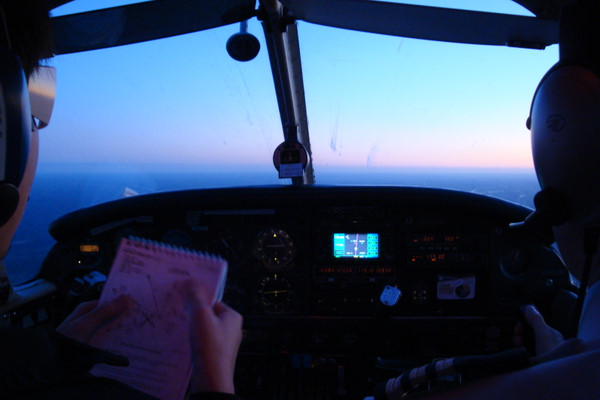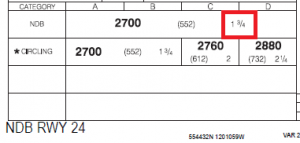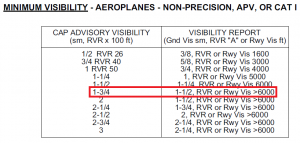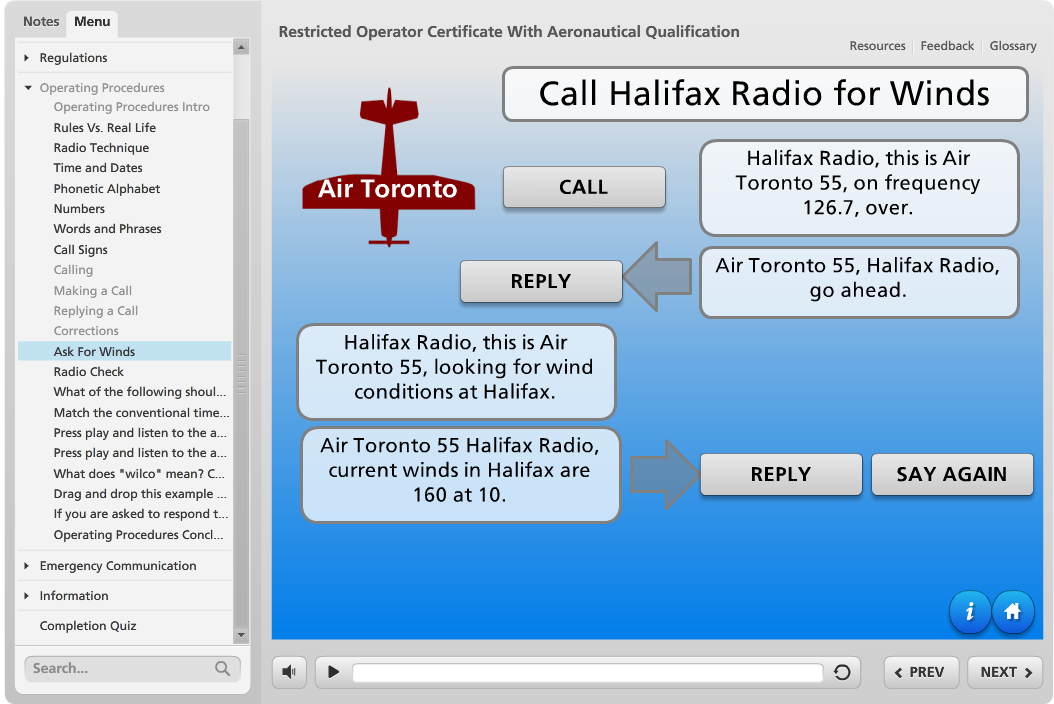Understanding Commercial Approach Ban for Canadian Operators

Canada’s approach ban rules are more complicated under commercial operations than in general aviation. In this post I hope to explain how to interpret the approach ban for commercial operators, with and without an Operations Specification (ops spec).
When you are ready you can try this interactive Commercial Approach Ban Quiz
Quick Review
Commercial operators in Canada fall under Part VII of the Canadian Aviation Regulation (CARs). CAR 700.10 explains that for an aircraft to conduct an approach the required visibility must meet what is set out in the Canadian Air Pilot (CAP). If the visibility for the runway of intended use is lower than what is required, the approach can not be started and/or must be discontinued unless:
- the aircraft has passed the Final Approach Fix (FAF) inbound, or is on the final approach course where there is no FAF
- the aircraft is on a training flight and the pilot in command (PIC) has informed air traffic control (ATC) that a missed approach will be conducted at or prior to decision altitude/height or minimum descent altitude
- the runway visual range (RVR) is fluctuating above and below the required value
- the ground visibility is fluctuating above and below the required value
- the pilot observes the visibility along the approach and runway that meets the value in the CAP
- the aircraft is operating under an ops spec
Interpreting Visibility
In commercial aviation we follow this order:
- RVR
- runways with RVA A & B, RVR A is used
- runways with RVA A unserviceable can use RVA B
- runway visibility
- ground visibility (aerodromes south of the 60th parallel of north latitude)
It is important to note the difference between runway visibility and ground visibility.
runway visibility: means the distance along a runway over which a person can see and recognize a visibility marker or lights having an intensity of more or less 1,000 candelas
ground visibility: in respect of an aerodrome, means the visibility at that aerodrome as contained in a weather observation reported by:
- an air traffic control unit
- a flight service station
- a community aerodrome radio station
- an AWOS used by the Department of Transport, the Department of National Defence or the Atmospheric Environment Service for the purpose of making aviation weather observations
-
a radio station that is ground-based and operated
by an air operator
Commercial Operators (No Ops Spec)
Always refer to the most current CAP. Visit NAV CANADA’s site to download the most current CAP GEN for free: here.
When flying towards an aerodrome, after selecting the approach of choice, refer to the advisory visibility on the CAP. This value is published in statute miles and RVR, or just statute miles. In the example approach plate, the pilots have selected the NDB 24. The advisory visibility from the plate is 1-3/4. Looking in the CAP GEN under approach ban for commercial operators “MINIMUM VISIBILITY – AEROPLANES – NON-PRECISION, APV, OR CAT I” you can see that with an Advisory Visibility of 1-3/4 there must be a visibility of 1-1/2 or >6000 RVR runway visibility to commence the approach.
Commercial Operators (With Ops Spec)
A Commercial Operator who is authorized under their operating certificate with an ops spec may apply low limits to approach ban. For details regarding what is required for these lower limits, refer to the CARs: Air Taxi: 703.41, Commuter: 704.37, Airline 705.48. (See Important Reminders About Ops Specs below)
When flying towards an aerodrome, after selecting the approach of choice, refer to the advisory visibility on the CAP. This value is published in statute miles and RVR, or just statute miles. In the example approach plate, the pilots have selected the NDB 24. The advisory visibility from the plate is 1-3/4. Looking in the CAP GEN under approach ban for commercial operators “MINIMUM VISIBILITY – AEROPLANES – 703/704/705 OPS SPEC – NON-PRECISION, APV, OR CAT I” you can see that with an Advisory Visibility of 1-3/4 there must be a visibility of 1 or 5000 RVR runway visibility to commence the approach.
Important Reminders About Ops Specs
When flying under an ops spec you must comply with the conditions set out in the CARs: Air Taxi: 703.41, Commuter: 704.37, Airline 705.48. The CARs stipulate crew, aircraft equipment, type of approach and runway equipment requirements. For example, in a 705 operation, in order to use the ops spec for an ILS without a HUD (Head Up Display), the following conditions apply:
- authorized on the operator’s certificate
- use pilot-monitored-approach procedures (PMA) or both pilots are authorized to fly CAT II approaches
- the aircraft has:
- a flight director and autopilot capable of flying an approach to 200′ AGL or lower or
- a flight director capable of flying an approach to 200′ AGL or lower and the pilots use PMA
- the runway is equipped with serviceable high- intensity approach lighting, high-intensity runway centreline lighting and high-intensity runway edge lighting
In this example, if these conditions can not be met the ops spec can not be applied and the crew must use visibility requirements for operators with no ops spec.
Air Taxi 703.41
Approach Bans — Non-precision Approach, APV and CAT I Precision
- 703.41 (1) For the purposes of subsections (2) to (4), the visibility with respect to an aeroplane is less than the minimum visibility required for a non-precision approach, an APV or a CAT I precision approach if, in respect of the advisory visibility specified in the Canada Air Pilot and set out in column I of an item in the table to this section,
- (a) where the RVR is measured by RVR “A” and RVR “B”, the RVR measured by RVR “A” for the runway of intended approach is less than the visibility set out in column II of the item for the approach conducted;
- (b) where the RVR is measured by only one of RVR “A” and RVR “B”, the RVR for the runway of intended approach is less than the visibility set out in column II of the item for the approach conducted;
- (c) where no RVR for the runway of intended approach is available, the runway visibility is less than the visibility set out in column II of the item for the approach conducted; or
- (d) where the aerodrome is located south of the 60th parallel of north latitude and no RVR or runway visibility for the runway of intended approach is available, the ground visibility at the aerodrome where the runway is located is less than the visibility set out in column II of the item for the approach conducted.
- (2) No person shall continue a non-precision approach or an APV unless
- (a) the air operator is authorized to do so in its air operator certificate;
- (b) the aeroplane has a minimum flight crew composed of a pilot-in-command and a second-in-command;
- (c) if the flight crew does not use pilot-monitored-approach procedures, the aeroplane is equipped with an autopilot capable of conducting a non-precision approach or an APV to 400 feet AGL or lower;
- (d) the instrument approach procedure is conducted to straight-in minima; and
- (e) a visibility report indicates that
- (i) the visibility is equal to or greater than that set out in subsection (1),
- (ii) the RVR is varying between distances less than and greater than the minimum RVR set out in subsection (1), or
- (iii) the visibility is less than the minimum visibility set out in subsection (1) and, at the time the visibility report is received, the aeroplane has passed the FAF inbound or, where there is no FAF, the point where the final approach course is intercepted.
- (3) No person shall continue an SCDA non-precision approach unless
- (a) the air operator is authorized to do so in its air operator certificate;
- (b) the aeroplane has a minimum flight crew composed of a pilot-in-command and a second-in-command;
- (c) if the flight crew does not use pilot-monitored-approach procedures, the aeroplane is equipped with an autopilot capable of conducting a non-precision approach to 400 feet AGL or lower;
- (d) the instrument approach procedure is conducted to straight-in minima with a final approach course that meets the requirements of section 723.41 of Standard 723 — Air Taxi — Aeroplanes of the Commercial Air Service Standards;
- (e) the final approach segment is conducted using a stabilized descent with a planned constant descent angle specified in section 723.41 of Standard 723 — Air Taxi — Aeroplanes of the Commercial Air Service Standards; and
- (f) a visibility report indicates that
- (i) the visibility is equal to or greater than that set out in subsection (1),
- (ii) the RVR is varying between distances less than and greater than the minimum RVR set out in subsection (1), or
- (iii) the visibility is less than the minimum visibility set out in subsection (1) and, at the time the visibility report is received, the aeroplane has passed the FAF inbound or, where there is no FAF, the point where the final approach course is intercepted.
- (4) No person shall continue a CAT I precision approach to a runway with centreline lighting unless
- (a) the air operator is authorized to do so in its air operator certificate;
- (b) the aeroplane has a minimum flight crew composed of a pilot-in-command and a second-in-command;
- (c) the aeroplane is equipped with
- (i) a flight director and autopilot capable of conducting a coupled precision approach to 200 feet AGL or lower, or
- (ii) if the flight crew uses pilot-monitored-approach procedures, a flight director capable of conducting a precision approach to 200 feet AGL or lower;
- (d) the runway is equipped with serviceable high-intensity approach lighting, high-intensity runway centreline lighting and high-intensity runway edge lighting; and
- (e) a visibility report indicates that
- (i) the visibility is equal to or greater than that set out in subsection (1),
- (ii) the RVR is varying between distances less than and greater than the minimum RVR set out in subsection (1), or
- (iii) the visibility is less than the minimum visibility set out in subsection (1) and, at the time the visibility report is received, the aeroplane has passed the FAF inbound or, where there is no FAF, the point where the final approach course is intercepted.
Commuter 704.37
Approach Bans — Non-precision, APV, and CAT I Precision
- 704.37 (1) For the purposes of subsections (2) to (4), the visibility with respect to an aeroplane is less than the minimum visibility required for a non-precision approach, an APV or a CAT I precision approach if, in respect of the advisory visibility specified in the Canada Air Pilot and set out in column I of an item in the table to this section,
- (a) where the RVR is measured by RVR “A” and RVR “B”, the RVR measured by RVR “A” for the runway of intended approach is less than the visibility set out in column II of the item for the approach conducted;
- (b) where the RVR is measured by only one of RVR “A” and RVR “B”, the RVR for the runway of intended approach is less than the visibility set out in column II of the item for the approach conducted;
- (c) where no RVR for the runway of intended approach is available, the runway visibility is less than the visibility set out in column II of the item for the approach conducted; or
- (d) where the aerodrome is located south of the 60th parallel of north latitude and no RVR or runway visibility for the runway of intended approach is available, the ground visibility at the aerodrome where the runway is located is less than the visibility set out in column II of the item for the approach conducted.
- (2) No person shall continue a non-precision approach or an APV unless
- (a) the air operator is authorized to do so in its air operator certificate;
- (b) the aeroplane is equipped with
- (i) if the flight crew does not use pilot-monitored-approach procedures, an autopilot capable of conducting a non-precision approach or an APV to 400 feet AGL or lower, or
- (ii) a HUD capable of conducting a non-precision approach or an APV to 400 feet AGL or lower;
- (c) the instrument approach procedure is conducted to straight-in minima; and
- (d) a visibility report indicates that
- (i) the visibility is equal to or greater than that set out in subsection (1),
- (ii) the RVR is varying between distances less than and greater than the minimum RVR set out in subsection (1), or
- (iii) the visibility is less than the minimum visibility set out in subsection (1) and, at the time the visibility report is received, the aeroplane has passed the FAF inbound or, where there is no FAF, the point where the final approach course is intercepted.
- (3) No person shall continue an SCDA non-precision approach unless
- (a) the air operator is authorized to do so in its air operator certificate;
- (b) the aeroplane is equipped with
- (i) if the flight crew does not use pilot-monitored-approach procedures, an autopilot capable of conducting a non-precision approach to 400 feet AGL or lower, or
- (ii) a HUD capable of conducting a non-precision approach to 400 feet AGL or lower;
- (c) the instrument approach procedure is conducted to straight-in minima with a final approach course that meets the requirements of section 724.37 of Standard 724 — Commuter Operations — Aeroplanes of the Commercial Air Service Standards;
- (d) the final approach segment is conducted using a stabilized descent with a planned constant descent angle specified in section 724.37 of Standard 724 — Commuter Operations — Aeroplanes of the Commercial Air Service Standards; and
- (e) a visibility report indicates that
- (i) the visibility is equal to or greater than that set out in subsection (1),
- (ii) the RVR is varying between distances less than and greater than the minimum RVR set out in subsection (1), or
- (iii) the visibility is less than the minimum visibility set out in subsection (1) and, at the time the visibility report is received, the aeroplane has passed the FAF inbound or, where there is no FAF, the point where the final approach course is intercepted.
- (4) No person shall continue a CAT I precision approach to a runway with centreline lighting or a CAT I precision approach in an aeroplane equipped with a HUD unless
- (a) the air operator is authorized to do so in its air operator certificate;
- (b) in the case of an aeroplane not equipped with a HUD,
- (i) if the flight crew does not use pilot-monitored-approach procedures, the pilot-in-command and the second-in-command are qualified to conduct a CAT II precision approach,
- (ii) the aeroplane is equipped with
- (A) a flight director and autopilot capable of conducting a coupled precision approach to 200 feet AGL or lower, or
- (B) if the flight crew uses pilot-monitored-approach procedures, a flight director capable of conducting a precision approach to 200 feet AGL or lower, and
- (iii) the runway is equipped with serviceable high-intensity approach lighting, high-intensity runway centreline lighting and high-intensity runway edge lighting;
- (c) in the case of an aeroplane equipped with a HUD capable of conducting a precision approach to 200 feet AGL or lower,
- (i) the pilot-in-command and the second-in-command are qualified to conduct a CAT II precision approach,
- (ii) the aeroplane is equipped with a flight director and autopilot capable of conducting a coupled precision approach to 200 feet AGL or lower, and
- (iii) the runway is equipped with serviceable high-intensity approach lighting and high-intensity runway edge lighting; and
- (d) a visibility report indicates that
- (i) the visibility is equal to or greater than that set out in subsection (1),
- (ii) the RVR is varying between distances less than and greater than the minimum RVR set out in subsection (1), or
- (iii) the visibility is less than the minimum visibility set out in subsection (1) and, at the time the visibility report is received, the aeroplane has passed the FAF inbound or, where there is no FAF, the point where the final approach course is intercepted.
Airline 705.48
Approach Bans — Non-precision, APV and CAT I Precision
- 705.48 (1) For the purposes of subsections (2) to (4), the visibility with respect to an aeroplane is less than the minimum visibility required for a non-precision approach, an APV or a CAT I precision approach if, in respect of the advisory visibility specified in the Canada Air Pilot and set out in column I of an item in the table to this section,
- (a) where the RVR is measured by RVR “A” and RVR “B”, the RVR measured by RVR “A” for the runway of intended approach is less than the visibility set out in column II of the item for the approach conducted;
- (b) where the RVR is measured by only one of RVR “A” and RVR “B”, the RVR for the runway of intended approach is less than the visibility set out in column II of the item for the approach conducted;
- (c) where no RVR for the runway of intended approach is available, the runway visibility is less than the visibility set out in column II of the item for the approach conducted; or
- (d) where the aerodrome is located south of the 60th parallel of north latitude and no RVR or runway visibility for the runway of intended approach is available, the ground visibility at the aerodrome where the runway is located is less than the visibility set out in column II of the item for the approach conducted.
- (2) No person shall continue a non-precision approach or an APV unless
- (a) the air operator is authorized to do so in its air operator certificate;
- (b) the aeroplane is equipped with
- (i) if the flight crew does not use pilot-monitored-approach procedures, an autopilot capable of conducting a non-precision approach or an APV to 400 feet AGL or lower, or
- (ii) a HUD capable of conducting a non-precision approach or an APV to 400 feet AGL or lower;
- (c) the instrument approach procedure is conducted to straight-in minima; and
- (d) a visibility report indicates that
- (i) the visibility is equal to or greater than that set out in subsection (1),
- (ii) the RVR is varying between distances less than and greater than the minimum RVR set out in subsection (1), or
- (iii) the visibility is less than the minimum visibility set out in subsection (1) and, at the time the visibility report is received, the aeroplane has passed the FAF inbound or, where there is no FAF, the point where the final approach course is intercepted.
- (3) No person shall continue an SCDA non-precision approach unless
- (a) the air operator is authorized to do so in its air operator certificate;
- (b) the aeroplane is equipped with
- (i) if the flight crew does not use pilot-monitored-approach procedures, an autopilot capable of conducting a non-precision approach to 400 feet AGL or lower, or
- (ii) a HUD capable of conducting a non-precision approach to 400 feet AGL or lower;
- (c) the instrument approach procedure is conducted to straight-in minima with a final approach course that meets the requirements of section 725.48 of Standard 725 — Airline Operations — Aeroplanes of the Commercial Air Service Standards;
- (d) the final approach segment is conducted using a stabilized descent with a planned constant descent angle specified in section 725.48 of Standard 725 — Airline Operations — Aeroplanes of the Commercial Air Service Standards; and
- (e) a visibility report indicates that
- (i) the visibility is equal to or greater than that set out in subsection (1),
- (ii) the RVR is varying between distances less than and greater than the minimum RVR set out in subsection (1), or
- (iii) the visibility is less than the minimum visibility set out in subsection (1) and, at the time the visibility report is received, the aeroplane has passed the FAF inbound or, where there is no FAF, the point where the final approach course is intercepted.
- (4) No person shall continue a CAT I precision approach to a runway with centreline lighting or a CAT I precision approach in an aeroplane equipped with a HUD unless
- (a) the air operator is authorized to do so in its air operator certificate;
- (b) in the case of an aeroplane not equipped with a HUD,
- (i) if the flight crew does not use pilot-monitored-approach procedures, the pilot-in-command and the second-in-command are qualified to conduct a CAT II precision approach,
- (ii) the aeroplane is equipped with
- (A) a flight director and autopilot capable of conducting a coupled precision approach to 200 feet AGL or lower, or
- (B) if the flight crew uses pilot-monitored-approach procedures, a flight director capable of conducting a precision approach to 200 feet AGL or lower, and
- (iii) the runway is equipped with serviceable high-intensity approach lighting, high-intensity runway centreline lighting and high-intensity runway edge lighting;
- (c) in the case of an aeroplane equipped with a HUD capable of conducting a precision approach to 200 feet AGL or lower,
- (i) the pilot-in-command and the second-in-command are qualified to conduct a CAT II precision approach,
- (ii) the aeroplane is equipped with a flight director and autopilot capable of conducting a coupled precision approach to 200 feet AGL or lower, and
- (iii) the runway is equipped with serviceable high-intensity approach lighting and high-intensity runway edge lighting; and
- (d) a visibility report indicates that
- (i) the visibility is equal to or greater than that set out in subsection (1),
- (ii) the RVR is varying between distances less than and greater than the minimum RVR set out in subsection (1), or
- (iii) the visibility is less than the minimum visibility set out in subsection (1) and, at the time the visibility report is received, the aeroplane has passed the FAF inbound or, where there is no FAF, the point where the final approach course is intercepted.
Low Visibility Operations (LVOP)
Remember to consider the level of service for a particular runway. In low visibility operations a runway may have a level of service greater than the approach ban visibility. Level of service is found in the Canada Flight Supplement under runway data.
Approach Ban for United States
There is no calculations to consider. The approach ban is based on the advisory visibility published on the approach plate. So, if the plate says 1-1/4, the approach ban is 1-1/4.
Conclusion
It is important to understand the standard visibility requirements that would allow you to conduct an approach. If your commercial operation has an ops spec it is important to understand the conditions, remembering also that there are differences between Air Taxi, Commuter and Airline. Always reference the most current version of the CARs, and CAP.
More Information and Sources
- Canadian Aviation Regulations (http://www.tc.gc.ca/eng/civilaviation/regserv/cars/menu.htm)
- Canada Air Pilot (http://products.navcanada.ca/Subscription-Products/Electronic-Publications-Download-Subscriptions?search=cap+gen)










Great article! Concise, well written and helpful
A few questions:
1) What if the airport you are flying to is uncontrolled with no AWOS ? like the ones up north. Does the approach ban apply ?
2) What if you are a GA aircraft and you are flying to an airport that has No RVR ? ( I couldnt find ground visibility anywhere in CAPGEN for GA)
Hello MJ. Sorry for the slow response. You have asked some great questions, and I hope I can give you a clear answer.
1. Check out AIM 9.19.2.5. If there is no RVR, runway visibility, or ground visibility reported, there is no approach ban. Also, if you are flying to an airport north of 60 degrees, ground visibility does not impose an approach ban.
2. For general aviation, if there is no RVR, there is approach ban. You can see more about this in the AIM 9.12.2.1.
Feel free to email me if you have any questions, [email protected].
Thanks for taking the time to clarify this rule. Fly safe.